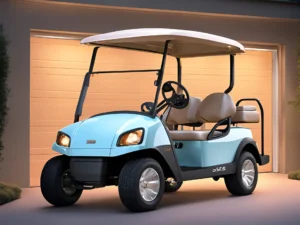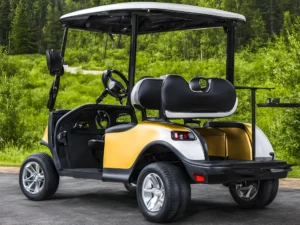Introduction to E-Z-Go Golf Carts
E-Z-Go golf carts are a popular choice among both golf enthusiasts and recreational users due to their reliability, performance, and versatility. Founded in 1954, E-Z-Go has established itself as a leading manufacturer in the golf cart industry, producing a wide range of models tailored to various needs—whether it is for navigating a golf course, assisting with transportation in communities, or serving utility roles in commercial settings. The brand’s commitment to quality and innovation has positioned E-Z-Go as a trusted name, relied upon by countless users globally.
Understanding the basic mechanics of E-Z-Go golf carts, particularly their transmission systems, is essential for users to effectively troubleshoot common issues. Golf carts typically feature two types of transmissions: electric and gas. Electric models rely on a battery-powered motor, making them environmentally friendly and ideal for quieter environments. In contrast, gas-powered models use a combustion engine, offering greater power and longer ranges, making them suitable for more extensive terrains. Each type has its unique characteristics that affect usability, performance, and maintenance.
The transmission system of an E-Z-Go golf cart plays a critical role in providing smooth acceleration and deceleration and allows for optimal power transfer from the engine or motor to the wheels. However, as with any mechanical system, users may encounter transmission problems over time. Issues such as slippage, poor acceleration, or unusual noises can indicate a need for inspection or repair. Being aware of these basic mechanics helps users identify potential problems early, thus ensuring their golf carts remain in excellent working condition.
Identifying Transmission Problems in E-Z-Go Golf Carts
Recognizing transmission issues in E-Z-Go golf carts is crucial for maintaining optimal performance and prolonging the cart’s life. There are several key indicators that users can observe, which may signify underlying problems with the transmission system.
First, unusual noises are often a primary symptom. If you hear grinding, whining, or clunking sounds emanating from the transmission area, this could indicate worn or damaged components. These noises can arise from various transmission parts, such as gears or bearings, that are failing to function correctly.
Another common sign of transmission trouble is slipping gears. This condition occurs when the golf cart unexpectedly loses power while running or when it hesitates to respond to acceleration. If you notice that the E-Z-Go golf cart struggles to maintain speed, or if it feels as if it’s in neutral despite being in gear, this could point to a malfunctioning transmission.
Difficulty shifting gears is also a clear warning sign. E-Z-Go golf carts are designed to transition smoothly between different gears, and any resistance or inability to shift can indicate serious transmission issues. This may also be accompanied by a noticeable delay in response when the gear lever is engaged.
Lastly, reduced power during operation is an essential indicator that the transmission system might not be functioning as intended. If you find that your E-Z-Go golf cart is unable to climb hills or reach its usual speed, it may be beneficial to investigate the transmission components. Addressing these issues promptly can help avoid more severe damage and maintain the reliability of your golf cart.
Common Causes of Transmission Problems
Transmission problems in E-Z-Go golf carts can stem from a variety of factors, each contributing to the overall functionality and performance of the vehicle. One of the most prevalent causes is the wear and tear of components over time. Regular use of the golf cart places significant stress on its parts, leading to deterioration, particularly in the transmission system. When components such as belts, bearings, or gears become worn out, they may not function efficiently, ultimately resulting in transmission issues.
Another significant factor contributing to transmission problems is a lack of proper maintenance. E-Z-Go golf carts, like any mechanical vehicles, require periodic inspections and servicing to ensure optimal performance. Neglecting routine maintenance can lead to various transmission complications, as dirt and debris accumulate, impairing the smooth operation of components. Tasks such as changing the transmission fluid, adjusting belts, and checking for proper alignment are critical in preventing potential failures.
Fluid leaks can also significantly impact the transmission’s effectiveness in E-Z-Go golf carts. The fluid acts as both a lubricant and a coolant, and any loss of this vital resource can lead to overheating and subsequent damage to the transmission system. Regularly checking for any signs of leakage and ensuring proper fluid levels can help mitigate this risk.
Overheating poses another serious risk to the transmission in E-Z-Go golf carts. Operating the cart under heavy loads or in extremely hot conditions can lead to overheating, causing the fluid to break down and components to warp. Lastly, manufacturing defects, while less common, can also lead to transmission problems. It is essential for owners to remain vigilant for any signs of transmission issues and address them promptly to maintain the longevity and efficiency of their E-Z-Go golf cart.
Transmission Fluid and its Importance
Transmission fluid plays a crucial role in the functioning of E-Z-Go golf carts, serving not only as a lubricant but also as a coolant and hydraulic fluid. This specialized fluid is designed to reduce friction between the moving parts of the transmission system, allowing for smooth gear transitions and efficient power delivery from the engine to the wheels. Maintaining the correct level and quality of transmission fluid is vital for ensuring optimal performance and longevity of an E-Z-Go golf cart.
The quality of transmission fluid can significantly influence the overall operation of the golf cart. Over time, fluid can become contaminated with dirt, debris, and metal particles due to wear and tear on the internal components. This degradation can lead to decreased lubrication effectiveness, making it difficult for the transmission to function smoothly. If left unchecked, dirty or low transmission fluid can result in overheating and increased wear, potentially leading to costly repairs and diminished performance.
Regular checks of the fluid level are essential for the proper maintenance of an E-Z-Go golf cart. It is advisable to refer to the manufacturer’s recommendations regarding fluid type and replacement intervals. Typically, performing a routine inspection to ensure that the transmission fluid is at the correct level will help prevent issues such as slipping gears, delayed engagement, or a complete transmission failure. Additionally, changing the transmission fluid according to a scheduled maintenance plan will help in prolonging the lifespan of the golf cart’s transmission system.
In conclusion, understanding the role of transmission fluid in E-Z-Go golf carts is indispensable for any owner. By prioritizing regular checks and maintenance of the transmission fluid levels and quality, owners can significantly enhance the performance and reliability of their golf carts, ensuring an enjoyable golfing experience on the course.
Basic Troubleshooting Steps for Owners
For owners of an E-Z-Go golf cart, understanding how to perform basic troubleshooting can be instrumental in diagnosing and potentially resolving minor transmission issues. A proactive approach can often save time and reduce repair costs.
Begin your troubleshooting process with a visual inspection of the transmission components. Look for any noticeable signs of wear, damage, or loose connections. Pay special attention to the drive belt, as a worn or frayed belt can lead to performance problems. Additionally, ensure that there are no leaks around the transmission area, which could indicate fluid loss and further complications.
Next, checking the fluid levels is crucial. E-Z-Go golf carts typically rely on a specific type of transmission fluid, and insufficient levels can impede proper function. Locate the transmission fluid dipstick, if applicable, and assess the fluid level. If the level appears low, top it off with the recommended type of fluid. Moreover, it’s important to inspect the fluid condition; if it is dirty or discolored, consider a fluid change to maintain optimal transmission health.
Another critical step includes listening for specific noises while the cart is in operation. Unusual sounds, such as grinding, clunking, or excessive whining, may suggest underlying issues within the transmission system. Observing these auditory indicators can help narrow down possible problems, allowing you to gather valuable information before seeking professional help.
Incorporating these basic troubleshooting steps can significantly aid E-Z-Go golf cart owners in identifying minor transmission problems early on. Developing an understanding of the common signs of trouble empowers users to take action, potentially avoiding larger issues in the future.
When to Seek Professional Help
Owning an E-Z-Go golf cart often entails regular maintenance and occasional troubleshooting. While many minor issues can be addressed by the owner, recognizing when to seek professional help is crucial for the prolonged efficiency and safety of the vehicle. Certain scenarios warrant the involvement of a qualified mechanic, as attempting to resolve complex problems without the requisite knowledge can lead to further complications.
One of the primary signs indicating the need for professional assistance is a noticeable change in performance. For instance, if your E-Z-Go golf cart struggles to accelerate, experiences erratic deceleration, or makes unusual noises during operation, these could be indicative of underlying transmission problems. Ignoring such symptoms may lead to more severe damage, necessitating costly repairs down the line.
Additionally, if you encounter issues with the gear shifting—whether the cart refuses to shift gears or seems stuck in one gear—it is advisable to consult a mechanic. Transmission systems are intricate, and a failure to shift can stem from various causes, including a malfunctioning control cable or a problem with the transmission fluid itself. A qualified technician can diagnose the issue accurately and recommend the appropriate solutions.
Other scenarios that should prompt you to contact a professional include leaking transmission fluid, an overheating engine, or a complete loss of power while driving. These issues may not only disrupt your golf game but can also pose safety risks. In cases where you notice fluid accumulation beneath the cart, it is best not to delay in consulting a mechanic. Regular check-ups by a professional specializing in E-Z-Go golf carts can help maintain performance and enhance the longevity of the vehicle.
Preventative Maintenance Tips for E-Z-Go Golf Carts
Maintaining an E-Z-Go golf cart requires attention to detail and regular upkeep to ensure optimal performance and longevity. Owners can significantly reduce the risk of transmission problems by implementing a series of preventative maintenance practices. Routine inspections are crucial; at least once a month, check the belts and cables for signs of wear or damage. Any fraying or cracking may indicate a need for replacement to prevent further issues.
Fluid levels are another essential aspect of maintenance. Regularly inspect the transmission fluid—this is vital for ensuring smooth gear shifts and overall functionality. It is recommended to change the transmission fluid every 100 hours of operation or at least once a year to prevent buildup of contaminants that can lead to transmission failure. Alongside this, ensure that the oil in the engine is also kept at the proper levels, and schedule oil changes as needed.
Environmental factors, such as moisture, can also harm golf carts and lead to transmission problems. To combat this, keeping the E-Z-Go golf cart clean is imperative. After every use, particularly in wet conditions, wash the cart to remove dirt, mud, and moisture that can cause corrosion. Additionally, consider the use of protective covers when the cart is not in use, especially in harsh weather conditions, to shield it from the elements.
Lastly, it is essential to regularly check the battery and electrical connections, as these are integral to the functioning of the golf cart. Clean any accumulated grime around terminals and ensure that connections are secure to prevent electrical issues that might indirectly impact the transmission. By adhering to these preventative maintenance tips, E-Z-Go golf cart owners can prolong the life of their vehicles and minimize the risk of transmission-related problems.
Repair and Replacement Options
When faced with transmission issues in an E-Z-Go golf cart, owners have several options for restoring its functionality. Understanding these choices is essential for making informed decisions that align with budget and technical capability.
For those who prefer a hands-on approach, do-it-yourself (DIY) repairs can be an economical choice. Many common transmission problems, such as slipping gears or unusual noises, can be diagnosed and potentially fixed with basic mechanical skills. Resources such as repair manuals and online forums dedicated to E-Z-Go models often provide valuable guidance, making it easier for hobbyists to tackle straightforward issues. However, it is crucial to have the right tools and follow safety precautions during such repairs. More complex problems may require specific expertise that exceeds typical DIY capabilities.
Another option is to replace faulty parts, which can be necessary in cases where wear and tear have significantly affected the cart’s transmission. E-Z-Go golf cart owners can source replacement components from various suppliers, including authorized dealers or aftermarket vendors. When purchasing replacement parts, it is advisable to compare prices and ensure compatibility with the specific model of the golf cart. Quality should also be a consideration, as opting for cheaper, lower-quality parts may lead to further problems down the line.
For those who are unsure about their ability to perform repairs, or who prefer a guaranteed solution, professional repair services are available. Many local golf cart service centers specialize in E-Z-Go models and can provide comprehensive diagnostics and repairs. While this option typically incurs higher costs, it can save time and ensure that the golf cart is returned to optimal working condition. Ultimately, the choice between DIY repairs, replacement parts, and professional services will depend on the severity of the transmission problem, technical expertise, and budget considerations.
Conclusion and Final Thoughts
In summary, understanding the transmission problems that can affect E-Z-Go golf carts is essential for both new and seasoned owners. Throughout this discussion, we have addressed various factors that can lead to transmission issues, including worn components, fluid levels, and environmental factors such as terrain. Each of these aspects plays a crucial role in the overall performance and longevity of the E-Z-Go golf cart’s transmission system.
Regular maintenance is paramount. By routinely checking the transmission fluid and ensuring all parts are in good working order, owners can often prevent the onset of more significant problems. Additionally, recognizing the early signs of transmission issues, such as unusual noises or difficulty shifting gears, can help in addressing these matters before they escalate into costly repairs or replacements.
Staying informed is equally important. The landscape of E-Z-Go golf carts continues to evolve, with advancements in technology and design that might introduce new challenges. Engaging with communities of E-Z-Go owners and seeking out expert advice can foster a deeper understanding of common transmission issues and effective solutions.
Ultimately, a proactive approach to maintaining an E-Z-Go golf cart not only enhances its performance but also ensures a safer and more enjoyable riding experience. As owners, being prepared and equipped with knowledge about potential transmission problems and their remedies allows one to enjoy the benefits of the E-Z-Go golf cart fully, contributing to its efficiency and reliability on the golf course or any terrain. Thus, fostering a culture of responsibility in maintenance can prolong the lifespan of the cart and ensure seamless operation for years to come.
Related More:
- Understanding Why Your Golf Cart Runs with the Key Off: A Troubleshooting Guide
- Golf Ball Bags: Combining Convenience and Style
- Golf Ball Markers: The Small Equipment with a Big Impact on Your Game
- Srixon Golf Balls: Revealing the Hidden Gems You Need to Know
- Fairway Revolution: The Hidden Power of Golf Ball Retrievers
- The Golf Ball Grinder: A Unique Tool for Every Golf Enthusiast
- The Art of Display: Creating the Perfect Golf Ball Display Case
- Vice Golf Balls Review: Performance, Quality, and Value Explored
- The Golf Ball Slide Mastery: Expert Tips for Optimal Control
- 2024: The Journey of Lost Golf Balls – Beyond the Fairway
- The Average Age of Golfers In Depth Look 2024
- Golf Club Selection Tips to Help You Choose the Right Club
- Golf Gloves Essentials 2024: Boost Your Game




